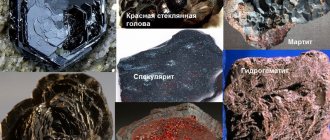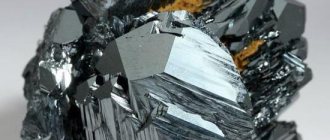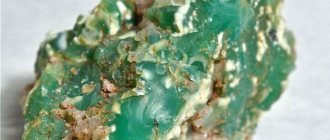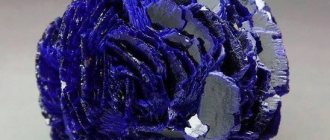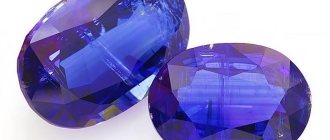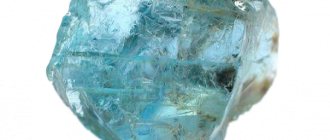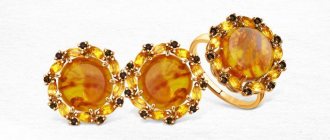| Category | Oxides and hydroxides |
| Title in English | Hematite |
| Formula | Fe2O3 |
| Group | Korunda Group |
| Color | Black red |
| Stroke color | Brown |
| Shine | Metallic, Matte |
| Transparency | Opaque |
| singonia | Trigonal |
| Hardness | 5 — 6 |
| Cleavage | Imperfect |
| Density, g/cm³ | 4,9 — 5,3 |
| Kink | Rough, Conchoidal |
| origin of name | The first description of the hematite stone is found in the Babylonian treatise on stones. This document was written back in the first century BC. Hematite has a characteristic bloody tint, and its peculiarity is that when it is processed, the water turns red. By the way, because of this, the Slavic peoples called the stone “bloody”. The word hematite is derived from the Greek haima, which translates as blood. |
| Morphology | Hematite crystals have lamellar and tabular shapes. In addition, the stone creates simple crystal shapes - these are rhombohedrons, pinacoids and scalenoerds. By the way, clusters of crystals located on planes are close to a pinacoid and form some kind of “iron roses”. Hematite most often occurs in the form of dense cryptocrystalline and earthy masses, foliated and scaly aggregates. |
There is hardly a stone that can compete with hematite in terms of the number of possible names. Thus, in Russian terminology, hematite is found under the name “bloody”, as a literal translation of the Greek word “hematitos”, that is, “like blood”. The old Latin name for the mineral, “sanguine,” also means “blood,” but hematite does not look like blood clots at all. In English terminology, hematites are known as “reflective stones” or specularites. In Germany they are called “iron shine”, and the rusty, knobby growths are called “red glass heads”. Additionally, hematite is variously referred to as “black diamond,” “martite,” and “mirror iron.”
Hematite deposits
Hematite deposits are quite widespread. High-quality samples of jewelry hematite are mined in the USA and Great Britain. Beautiful hematite roses are often found in the northern Urals. Hematites of Transbaikalia are distinguished by unusual shapes. Hematites found in Alaska are black in color and very shiny. They are cut like diamonds and become like black diamonds.
Deposits and varieties of hematite
In Russia , the Kursk anomaly is rich in hematite; there are deposits of it accompanying gold placers in the Urals (Bertevsky mine, Tagil).
In Kazakhstan there is a unique deposit with bluish hematite. Its surface is also distinguished by a relief pattern.
The extensive Krivoy Rog hematite deposit in Ukraine . Here are several decorative varieties of the mineral. In addition, Krivoy Rog hematite impregnates other rocks, giving them an unusually beautiful color. In union with hematite, for example, elegant red-banded quartzites with parallel or wavy colored stripes are formed - carmine, wax, red, gray, black, dark green. Such ferruginous quartzites resemble jasper and are called jaspilites (Jasper in English means “jasper”).
Rainbow hematite
A very beautiful variety of hematite mined in Brazil . The mineral has its own name – Rainbow hematite (“Rainbow hematite”). Its surface resembles the pattern of fabric for mattresses or beach loungers: it alternates wide parallel stripes of brown, greenish and bluish colors, generously strewn with festively sparkling quartz crystals.
Large deposits of hematite are located:
- USA
- Canada
- Britannia
- Germany
- Brazil
History of hematite
— Advertising —
The word hematite comes from the Greek heme, meaning blood, and refers to the red-brown color of the powder of this mineral, as well as its ability to color water red.
In Christianity, red spots on the stone were considered the blood of Christ, and for this reason, amulets were made from it in the form of the face of Jesus so that the red inclusions looked like blood on his hair.
Different peoples at different times paid attention to magical properties and used this stone. Thus, in Tibet they believed that the mineral protected its owner, especially a woman, from damage and the evil eye. The ancient Egyptians carved hematite scarab beetles.
Magic mirrors
In magic, hematite, which contains quartz, is especially in demand. These crystals enhance the wave manifestations of subtle energy fields. It is said that such artifacts are capable of generating visual fata morganas - hologram-like images of cities that disappeared in the distant past or the ghosts of long-dead people.
Magicians knew how to make magic mirrors from hematite, in which they could see what was happening hundreds of kilometers away.
Old Russian chronicles mention a strange artifact that looks like a magic mirror. It was located in the St. Sophia Cathedral in Kyiv. However, during the Mongol invasion (1242), the cathedral was robbed and half destroyed, and the mysterious mirror disappeared.
Physico-chemical characteristics of hematite
Hematites consist of silicon and iron oxides. Depending on their ratio, hematite crystals are colored red, gray or black. Their hardness on the Mohs scale is 6-6.5, specific gravity is 5.3 g/cm3, there is no cleavage, at the fracture they are uneven, conchoidal, opaque, with a metallic sheen.
How to determine the authenticity of a stone
It is not difficult to distinguish genuine hematite from a fake. Gemologists have developed a simple bar test.
For testing, you will need a white ceramic tile (only without glaze), an earthenware or porcelain cup, or any other unglazed white ceramic.
Determining the authenticity of hematite
Run the corner of the stone along it with pressure.
If a red line remains, you have real hematite in your hands. [Total votes: 3 Average: 4.7/5]
Types of hematite
— Advertising —
For natural hematites, several morphological subspecies are distinguished:
- Iron mica has a scaly, finely crystalline structure and has an iron tint.
- Specularites are distinguished by their crystalline structure and silvery-gray luster. Used as a decorative stone.
- Red Glasshead is a red ore with kidney-shaped stone inclusions.
- Iron Rose is a cluster of flat crystals that resembles a tea rose flower in appearance.
- Red iron ore is a brown mineral with a fine-crystalline structure and a dense arrangement of crystals.
What is it, hematite stone?
Hematite is opaque. However, its thin sections are capable of transmitting matte red light. The crystal structure of this mineral is similar to corundum, but bloodstone crystals are not so tightly bound. Most often they form scattered plates or scales, so the mineral is quite fragile. Under a microscope, the structure of the mineral is usually powdery.
There is an interesting shape of the mineral with large curved scales superimposed on each other, like petals. Collectors hunt for such specimens; they are called “iron roses.”
Ocher yellowish inclusions of mineral aggregates (geologists call them “swamp ores”) give hematite fragments a lemon tint. By the way, the official name of swamp ores is limonite.
Hematite crystal
Even less common are concretions with well-formed crystals. Such unique items adorn the collections of the largest mineralogical museums in the world.
The magical properties of hematite
Hematite is a symbol of courage.
Even in ancient times, it was believed that it gave its owner strength and invulnerability in battles, and preserved optimism, courage and the will to win. Therefore, warriors always took amulets made of hematites with them. In Rus' they believed that a piece of gem suspended over the cradle would protect the child from falls and injuries.
During the Middle Ages, hematite became an important attribute for magicians, wizards and alchemists. They used it to protect themselves from evil forces, appeal to the spirits of the elements, and even communicate with the dead.
Among Europeans, hematite was considered a talisman for warlocks.
In general, hematite improves a person’s energy state, strengthens the body and spirit. Helps its owner cope with attacks of anger and protects against rash actions, gives a feeling of self-confidence and security. It also promotes the rational use of energy, both your own and those around you.
What sign does the mineral suit?
Before using bloodstone, you need to know its astrological properties, which horoscopes it is combined with and who should avoid it.
| Zodiac sign | Compatibility |
| Aries | This zodiac sign often lives in a state of stress, since a quiet life is simply not interesting to him. The talisman will help prevent overexertion and “burnout” of such people. |
| Taurus | The mineral helps Taurus gain inspiration in creative processes and restore a sense of harmony with themselves. |
| Twins | Astrologers do not advise representatives of this sign to wear bloodstone. |
| Cancer | The crystal increases passion and tension in the nervous system, which negatively affects cancer. It was noted that under the influence of hematite, cancers improve their own aura and can manipulate people. |
| a lion | For Leos, using the gem will help restore health and direct energy into the right, income-generating business. |
| Virgo | For representatives of this horoscope, jewelry with a stone will help them gain self-confidence. They will reveal their sexuality and will be able to calmly make acquaintances with the opposite sex. |
| Scales | For Libra, hematite promises success in all areas of life. They will begin to make wise decisions, men will become more attractive in the eyes of women. |
| Scorpion | Bloodstone gives Scorpios cunning and courage. Thanks to the mineral, they will be able to turn almost everything in their favor. |
| Sagittarius | The healing properties of the gem include healing the circulatory system; it saves its owner, Sagittarius, from fits of rage and protects him from envious people. |
| Capricorn | Bloodstone will help representatives of this sign discover hidden, extrasensory abilities. Men gain self-confidence and become courageous. |
| Aquarius | The mineral helps Libras determine their place in life. It helps to gain confidence and liberates people. |
| Fish | For Pisces, the stone will improve health and add courage, which, as a result, will help them express themselves. |
Also read: Marble is a stone of harmony and warmth in relationships
Bloodstone is considered especially useful for some earth signs. So that it can be worn by representatives of “water” signs, it is recommended to put it under running water for 10 minutes, then wipe it off and apply it to the body so that it takes over the energy of the owner.
To find out who is suitable for a crystal from the signs of the air element, you need to squeeze it tightly in your hand; in the absence of irritation on the skin and the occurrence of unpleasant emotions, the stone can be used.
Hematite healing properties
In ancient times, hematite jewelry was used as a hemostatic agent for wounds and inflammatory processes.
Poor vision was treated with hematite powders. And in ancient Rome, during childbirth, women held hematite rosaries in their hands to reduce the intensity of uterine bleeding. Hematite has a good effect on blood circulation, helps normalize blood pressure, increases resistance to stress, and stimulates sexual function. The stone is used in the treatment of diseases of the liver, kidneys, spleen, and pancreas. Hematites also help with various genitourinary diseases.
In lithotherapy, hematite is known to help treat abscesses and blockages of blood vessels.
Jewelry forms of hematite
Hematite is a recognized ornamental mineral; its demand is high in the jewelry production industry. Hematite set in silver is especially good.
Ring with hematite
But few people know that pasty hematite powder (called “crocus”) is the best ancient means for polishing gold. Silver, bronze, platinum and crystal are polished with hematite crocus. The products acquire a beautiful shine with a reddish tint.
Hematite colors
Crushed hematite is always painted in a characteristic blood-red color. The color palette of large images begins with red-brown and ends with bright scarlet and cherry shades. The color of a hematite crystal, depending on the content and amount of impurities, can also vary from dark gray to black. Polished hematite has a characteristic bluish metallic tint.
Jewelry and amulets
Pendant
Polished hematite can be similar to morion (black quartz), obsidian (volcanic glass), jet, black flint.
The shades of the mineral from different deposits vary within the dark red range:
- cherry
- bluish-red
- like a Renkold plum
- lilac
- red-brown
The hematite stone owes these shades to microscopic quartz crystals. Hematite is distinguished from similar minerals by its pronounced metallic sheen.
Hematite balls
Polished balls of iron-black hematite with their velvety shine are similar to the rarest black pearls.
Hematite gem
In the collection of gems collected in the Hermitage, you can admire carved miniatures made by Iranian craftsmen on hematite.
How to distinguish real hematite from a fake
Natural hematite is widespread, but it is still more difficult to find and process than to counterfeit, which is why fakes appear on the market.
To check the authenticity of hematite, pay attention to the weight of the stone. The natural mineral contains a high percentage of iron, and therefore it is quite heavy, unlike fakes.
In addition, to identify fakes, a stone is passed over the light, rough surface of porcelain or ceramic product. A natural specimen will leave a blood-red mark on it.
Fakes
Hematite is quite common; there are many deposits on our planet where it is mined, so the cost of the stone and products made from it is relatively low. This means there is no particular need to fake it. However, sometimes they still occur. If you want to verify the authenticity of a mineral, the easiest way is to contact a specialist in the field of mineralogy. But you can conduct a series of tests yourself and pay attention to some features:
- take any object made from unglazed porcelain or earthenware and, applying force, run a stone over it; natural hematite will leave behind a dark red stripe;
- sometimes an alloy of steel, nickel and chromium sulfides is passed off as bloodstone; unlike natural stone, it has stronger magnetic properties;
- Sometimes ceramics or even plastic are used as a fake; in this case, the beads will be much lighter; hematite products have a noticeable weight.
Caring for hematite jewelry is quite simple. They need to be cleaned and washed without using household chemicals. You can remove dirt and dust accumulated in hard-to-reach places using a cotton swab dipped in a special product designed for cleaning natural stones or in alcohol or cologne.
To free the amulet from the negative energy “absorbed” by it, hold it in running water, perhaps under running water from a tap. Then carefully blot with a napkin. To add shine to beads and inserts, carefully rub them with a piece of wool, suede, or flannel.
Bloodstone is quite fragile. Mechanical impact or a fall may cause a crack or chip to form on it. The product should be stored in a box, case or bag made of thick, soft fabric (velvet, fleece, plush).
Interesting facts about hematite:
Hematite gives its owner courage and bravery, which is why the stone is considered a talisman for men, especially for the military. In ancient times, a piece of hematite was sewn into clothes, placed in shoes, or made into a pendant for all men going to war. It was believed that such a talisman would definitely protect a warrior from death, and also make his enemies weak. Hematite talismans help women with professional growth and starting new things. Hematites are best suited for silver frames. Men are recommended to wear rings with it on the right index finger, women - on the left.
- The Indians used hematites to obtain a red pigment, which they applied to the skin of the face before going on the warpath. It was concluded that the warrior was brave and courageous, and returned alive.
- In ancient times, mirrors were made from shiny hematites. However, later a legend spread that such a mirror could take the soul of anyone who looked into it, and such mirrors fell out of popularity.
Hematite and Zodiac
Who is hematite suitable for? Astrologers say that this is the mineral of Cancers and Scorpios. Hematite is located in the Zodiac sign of Aquarius and is also suitable for Capricorns.
Beads made of hematite
But such a beneficial effect of hematite is not available to everyone. Some horoscopes warn those born under the sign of Leo and Pisces against acquiring hematite. Signs that are incompatible with this mineral include Gemini.
Applications of hematite
The stone has been known to all cultures for a long time. Previously, it was ground into powder and used as a dye. Bloodstone made rock paintings in Asturias and Cantabria.
The brilliance of specularite made it possible to use it as a mirror. This is how the Aztecs used it. Many North American aborigines used the mineral powder to decorate their bodies. The Egyptians used the breed in painting, and made amulets and valuables from large formations.
The stone is involved in the smelting of cast iron
Hematite ore is a material used to produce cast iron. The breed is used in tempera painting, for making floor coverings, red lead, oilcloth, and durable enamel.
Iron rose is common in the jewelry industry. The breed is inexpensive and is used to make jewelry, small inserts, and carved items. Black diamond is used in glyptics.
Caring for products with hematite
Despite its density, hematite is a fragile mineral and should be carefully protected from damage. It is best to wear it in places where it is least susceptible to friction against clothing, as it can stain it and at the same time wear down its edges a little. This stone also does not withstand falls well and can be severely scratched or chipped if dropped on a hard surface.
The bloodstone discharges over time and collects all the negative energy. It should be removed with water. Dip the mineral under running water and leave for a few minutes. Then leave it in a dry place for several hours, after which it will be ready to serve you again.
How to charge hematite?
Stones with magical properties can accumulate negative energy when worn for a long time. Cleaning and charging the amulet after prolonged use or immediately after purchase is a mandatory ritual that can reveal all the amazing properties of the hematite mineral.
- After purchasing, the jewelry should be placed in a secluded place, wrapped in soft cloth.
- You can’t immediately put on jewelry with a mineral, the stone must “get used” to the owner, for this, from time to time over the course of a month, the jewelry must be taken out, picked up, held in the palms of your hands, and then put back.
- You can charge hematite by placing it on a windowsill on a clear night, so that it falls under the light of the Moon.
Artificial hematite
Synthetic stone is similar to natural stone, but costs less. Used in jewelry and making small decorations. Jewelers use magnetic hematite.
Trade names of artificial varieties:
- hemalayk;
- hematin.
There are two types of artificial mineral
The first is made from natural material, combining it with an adhesive base and pressing in a hot environment, then cutting it.
Hematin is an American development, similar in shade and specific gravity to natural stone. It is attracted by a magnet because it is an iron oxide.
Origin story
The black pearl takes its roots from ancient Rome and its name comes from the philosopher Theophrastus, who even then claimed that the hematite stone carries magical properties and is capable of healing. It also provides its owner with the ability to recognize signs of fate and influence a person’s will. But for all its positive qualities, the stone had no effect in witchcraft against humans and in other black rituals.
If translated literally, hematite is translated as “bloody.” Because of this, people began to call it bloody.
It was originally used by ancient people to paint cave paintings, and then became the basis for paints, which is also used by modern artists. It was also actively used by occultists in their magical rituals and attached special importance to the power of this stone. We must remember that stones bring health, happiness and good luck to some people, while to others, on the contrary, misfortune, illness and grief. Therefore, it is important to know the true power of minerals, their meaning and how they can affect your destiny.
Hematite
Use of stone among the ancient peoples of the world:
- In Egypt, it was an indispensable ritual attribute in worship of the goddess Isis.
- In Greece, legionnaires used it as an amulet of protection and always took it to battle.
- The Indians made paint from it, and then applied it to the body to give themselves a militant look. Cave drawings were made in the same way.
- In the era of antiquity, this mineral began to be actively used not only in rituals, but also in jewelry. It not only served as decoration, but also protected the owner from disease and damage.
- For sorcerers, the mineral served as the main component for potions, magical pictograms and mirrors, which served them as a tunnel between the world of the living and the world of the dead.
How to choose and wear hematite
When choosing, it is advised to listen to your inner feelings. You need to take the mineral in your hands and hold it for 5 minutes. If emotions of a positive nature arise, then the amulet will help and enhance the energy. Zodiac affiliation does not always play a significant role in such compatibility.
Tips for wearing a gem:
- choose comfortable bracelets, beads, rings, earrings;
- do not wear in hot weather, as stones leave burns on the skin;
- combine with everyday style of clothing;
- avoid regular wear if you are allergic to the substance;
- decorate the neck in case of blood flow disorders and choose rings in case of malfunction of blood vessels.
Amulets, jewelry or charms containing hematite cannot be combined with a number of stones. These are lapis lazuli, pearls, moonstone, carnelian, amber. It is also important what metal the gem is encased in. A silver frame will do.
Names and hematite
- Raisa - for her hematite is a stone of happiness. Before wearing, place the stone on the table and turn on spiritual music. If heliotrope lies nearby, it will enhance the verbal and sound effect on hematite.
- Natalia. Bloodstone will calm Natalia’s excessive pride and heightened sensuality.
- Anna. Bloodstone will protect her from self-destructive emotions.
- Peter - hematite will “anchor” some of Peter’s adventurism.
- Vadim. It is recommended to wear jewelry with hematite in adulthood.
- Nikita. A mineral talisman will give him optimism.
We recommend: ALPANIT - Swarovski's crystal fairy tale
Hematite
Recommended for Cancers, Scorpios
Hematite is essentially iron ore. Cherry-red or brownish-black iron ore. After the polishing procedure, it acquires the color of pigeon's blood with a metallic sheen. Sometimes it is called "bloody".
This gem has a lot of nicknames: red iron ore, iron luster, metal mica, red glass head. This is a stone, iron oxide of a black or dark red-brown hue, dense, opaque, with a metallic sheen. Named from the Greek word “haima” - blood, based on the color of the powder. For the same reason, it is often called bloody. Even the water used to process the mineral turns blood red.
Bloodstone is a stone of magicians, a gem that defeats the larva of the astral plane, protecting against any demonic attacks. A stone that enables work for astral protectors. It is also used to concentrate tantric energy and power. It also contains the forces of Mars.
It should be noted that in personal life, a bloodstone can release too much energy that a person will have in his body. At first this may not appear at all. Many people who wear bloodstone and know how to interact with it have all their enemies die completely unexpectedly. It turns out that this stone can create strong karma for you if you do not know how to cooperate with it. It can destroy its owner if he turns out to be a weak person (purely in the astral plane). As a result, it is contraindicated for weak people.
Not recommended for Gemini, Virgo, Pisces. All other signs can wear hematite. It is suitable for Cancers and Scorpios - this is their mineral. Scorpio is the only sign that can use this stone for magical work in the astral plane. Hematite, which must be faceted, should be worn by Scorpio representatives on the index finger of the right hand (for girls - on the left). It should only be set in cut silver, and for magical work - in copper. Combining bloodstone with Venus metal will give him this particular power.
Hematite increases the sexual attractiveness of the owner (or owner), strengthening him in sexual contacts. In powder consistency, hematite was used as a polishing compound (crocus), dense masses of a dark gray or black hue (especially radial sinter aggregates) were used in the form of jewelry and ornamental material for making additions to such jewelry as silver crosses, beads, brooches, carved miniatures (so-called gems) and other products, although hematite is difficult to polish and good polishing is obtained only after careful grinding.
Hematite is also called “iron lead” due to its characteristic red color and is used as a natural mineral paint. The most famous medical effect of hematite is the normalization of blood pressure and body weight.
In addition, it activates the functioning of the spleen, increases resistance to stress, improves energy, promotes optimism, mental fortitude and willpower. In ancient times, it was called mainly “bloody” due to the color of the powder and had a reputation for healing wounds, bleeding, inflammation and outbursts of rage or anger.
Named from the Greek. "ayma" - blood. The names are synonymous: black Alaskan diamond or black diamond, and popular: bloodstone. Bloodstone was widely used in medieval magic. The sorcerer did not dare to call upon the spirits without having with him a ring with bloodstone. Hematite (bloodstone) was actively used in ancient medicine as a hemostatic agent and is characterized in some cases as an analogue of magnetite. There is no reason to doubt that hematite beads or large inserts in necklaces or brooches are capable of creating a weak magnetic field. They believed that hematite healed abscesses, bladder diseases and venereal infectious diseases. Hematite has strong healing properties. Powders made from bloodstone were used to treat blurred vision, abscesses, bleeding, and inflammatory processes.
Our ancestors believed that wearing this stone makes the owner brave, strengthens the will, promotes a joyful, optimistic mood, and mental fortitude. Hematite can help you when you daydream too much and want a more down-to-earth outlook on life. This is a stone that encourages you to withstand difficult life challenges. Hematite serves as a strong protection against the evil eye. Hematite was used as a protective amulet against wounds on the battlefield. Grants invulnerability and suppresses outbursts of anger.
Hematite is a magical stone, a kind of energy shield and storage device at the same time. Wearing bloodstone is contraindicated for weak people due to its high activity. For some people, especially those with experience in magical practice, hematite can enhance internal energy. Such activity of the stone was explained by ancient magicians with the interaction of hematite and invisible forces - spirits. Undoubtedly, the influence of the iron contained in the stone is a powerful and capricious metal that has both protective and stimulating properties. Hematite should only be framed in silver cut.
The stone activates the spleen and has a positive effect on the circulatory system. M. Pylyaev writes that “bloodstone was once compared to the power to stop all bleeding.” I. Makeev, in an interesting manuscript “Mineralogical information about Russian monuments of the 16th-18th centuries,” cites the following recipe from an ancient Russian medical book: “...The stone is crushed into powder and mixed with gulaf water (distilled on rose flowers. - Author) and with gum, and in that pills are made and at sunset, when you go to bed, swallow them into one spool, and then the bloody vomiting will stop.” Hematite strengthens the physical and astral bodies.
Like jet, it treats diseases of the organs: liver, kidneys and pancreas. Increases resistance to nervous tension. The stone can be placed on organ areas where there are blockages and poor circulation. The bloodstone chakra is the root.
Color: from black to dark steel and rich cherry red.
Transparency: opaque.
Gloss: metallic.
Hardness: 5.5-6.5.
Chemical properties: widespread iron mineral Fe2O3, one of the most basic iron ores.
Prevalence:
Deposits are widespread throughout the Earth
Processing: DIY
Mineral deposits
Iron mica is found throughout the planet. Known deposits:
- Russian;
- American;
- Swiss;
- Brazilian;
- Italian;
- Ukrainian.
Iron pearls are mined all over the world
A particularly valuable species, the “iron rose,” is found in abundance in Switzerland. Samples in the form of bunches were found in the Czech Republic and England. Large unusual crystals are mined in Africa, South America, and southern Europe. Many vents are located near hydrothermal vents. Unusual specimens are mined in Alaska - they are beautiful, but covered with cracks and cannot be processed.
In 2004, bloodstone outcrops were discovered on Mars. They are believed to explain the color of the planet.
Place of Birth
On the earth's surface hematite deposits are:
- In Russia. Located in the Sverdlovsk and Irkutsk regions, in the Komi Republic.
- In Africa, it is mined in Morocco, Algeria, and the Republic of South Africa.
- In Europe, its deposits are located in the Czech Republic, Germany, Great Britain and Switzerland.
- Among the CIS countries, the leaders in production are Kazakhstan, Ukraine and Azerbaijan.
- Asian countries have also not lagged behind their competitors and the leading positions there are occupied by Iran, China and Mongolia.
- In North America in the USA, mountain deposits are located in the territories of Alaska and Michigan.
- In Latin America, it is actively mined in Mexico.
- On the South American continent, Brazil and Venezuela became the site of hematite deposits.
This is what mineral mining looks like
